Automatic Detection of Single Trees in Airborne Laser Scanning Data through Gradient Orientation Clustering
Abstract
1. Introduction
2. Materials
2.1. Study Areas
2.2. ALS Data and Reference Data
3. Methods
3.1. Obtain the CHM from ALS Data
3.2. Gradient Orientation Clustering
| Algorithm 1. Pseudocode of 4-N GOC. |
| Input: Output: Initialize:, , 1. for 2. for // Traversing every point in the matrix 3. // Select a current point from the matrix 4. if 5. // Clear the point set 6. end if 7. add to 8. if 9. 10. if 11. for in 12. // Set every point in map 13. end for 14. 15. 16. goto line 2; // Set a new index and start the next cycle 17. else 18. 19. goto line 4 // Set a new current point and do the above steps 20. end if 21. else 22. for in 23. // Set every point in map 24. end for 25. end if 26. end for 27. end for |
3.3. Single-Tree Selection
3.4. Parameters for Accuracy Evaluation
- Ntest: Number of extracted trees
- Nref: Number of reference trees
- Nmatch: Number of matched trees
- Hmean: Mean horizontal difference of the matching trees
- Vmean: Mean tree height difference of the matching trees
- Rextr (Extraction rate): Rextr = Ntest/Nref
- Rmat (Matching rate): Rmat = Nmatch/Nref
- Rcom (Commission rate): Rcom = (Ntest − Nmatch)/Ntest, where commission represents misrecognized of the test result.
- Rom (Omission rate): Rom = (Nref − Nmatch)/Nref, where omission represents leakage recognition of the reference data.
- RMS_H: Root mean square of Hmean.
- RMS_V: Root mean square of Vmean.
- RMS_Rextr: Root mean square of Rextr.
- RMS_Rmat: Root mean square of Rmat.
- RMS_Rcom: Root mean square of Rcom.
- RMS_Rom: Root mean square of Rom.
- RMS_M: Root mean square of matching score.
4. Experiment & Discussion
4.1. Analysis of Model Parameters
4.2. Results for Each Plot of the Dataset
4.3. Comparison with Previous Studies
4.4. Analysis of Matching Results for Different Forest Types
5. Conclusions
Author Contributions
Funding
Acknowledgments
Conflicts of Interest
References
- Kumar, J.; Talwar, P.; Krishna, A. Forest Canopy Density and ASTER DEM based Study for Dense Forest Investigation using Remote Sensing and GIS Techniques around East Singhbhum in Jharkhand, India. Int. J. Adv. Remote Sens. GIS 2015, 4, 1026–1032. [Google Scholar] [CrossRef]
- Nagendra, H.; Lucas, R.; Honrado, J.P.; Jongman, R.H.; Tarantino, C.; Adamo, M.; Mairota, P. Remote sensing for conservation monitoring: Assessing protected areas, habitat extent, habitat condition, species diversity, and threats. Ecol. Indic. 2013, 33, 45–59. [Google Scholar] [CrossRef]
- Garestier, F.; Dubois-Fernandez, P.C.; Champion, I. Forest height inversion using high-resolution P-band Pol-InSAR data. IEEE Trans. Geosci. Remote Sens. 2008, 46, 3544–3559. [Google Scholar] [CrossRef]
- Deo, R.K.; Russell, M.B.; Domke, G.M.; Andersen, H.E.; Cohen, W.B.; Woodall, C.W. Evaluating Site-Specific and Generic Spatial Models of Aboveground Forest Biomass Based on Landsat Time-Series and LiDAR Strip Samples in the Eastern USA. Remote Sens. 2017, 9, 598. [Google Scholar] [CrossRef]
- Yu, B.; Liu, H.; Wu, J. A method for urban vegetation classification using airborne LiDAR data and high resolution remote sensing images. J. Image Graph. 2010, 15, 782–789. [Google Scholar]
- Zhen, Z.; Quackenbush, L.J.; Zhang, L. Trends in automatic individual tree crown detection and delineation—Evolution of LiDAR data. Remote Sens. 2016, 8, 333. [Google Scholar] [CrossRef]
- Hyyppä, J.; Schardt, M.; Haggrén, H.; Koch, B.; Lohr, U.; Scherrer, H. HIGH-SCAN: The first European-wide attempt to derive single-tree information from laserscanner data. Photogramm. J. Finl. 2001, 17, 58–68. [Google Scholar]
- Popescu, S.C.; Wynne, R.H. Seeing the trees in the forest. Photogramm. Eng. Remote Sens. 2004, 70, 589–604. [Google Scholar] [CrossRef]
- Koch, B.; Heyder, U.; Weinacker, H. Detection of individual tree crowns in airborne lidar data. Photogramm. Eng. Remote Sens. 2006, 72, 357–363. [Google Scholar] [CrossRef]
- Hyyppä, J.; Holopainen, M.; Olsson, H. Laser scanning in forests. Mol. Divers. Preserv. Int. 2012, 4, 2919–2922. [Google Scholar] [CrossRef]
- Corona, P.; Cartisano, R.; Salvati, R.; Chirici, G.; Floris, A.; Di Martino, P. Airborne Laser Scanning to support forest resource management under alpine, temperate and Mediterranean environments in Italy. Eur. J. Remote Sens. 2012, 45, 27–37. [Google Scholar] [CrossRef]
- Nijland, W.; Coops, N.C.; Nielsen, S.; Stenhouse, G. Integrating optical satellite data and airborne laser scanning in habitat classification for wildlife management. Int. J. Appl. Earth Obs. Geoinf. 2015, 38, 242–250. [Google Scholar] [CrossRef]
- Maltamo, M.; Næsset, E.; Vauhkonen, J. Forestry Applications of Airborne Laser Scanning: Concepts and Case Studies; Springer: Berlin, Germany, 2014. [Google Scholar]
- Hyyppa, J.; Kelle, O.; Lehikoinen, M.; Inkinen, M. A segmentation-based method to retrieve stem volume estimates from 3-D tree height models produced by laser scanners. IEEE Trans. Geosci. Remote Sens. 2001, 39, 969–975. [Google Scholar] [CrossRef]
- Persson, A. Detecting and measuring individual trees using an airborne laser scanner. Photogramm. Eng. Remote Sens. 2002, 68, 925–932. [Google Scholar]
- Popescu, S.C.; Wynne, R.H.; Nelson, R.F. Estimating plot-level tree heights with lidar: Local filtering with a canopy-height based variable window size. Comput. Electron. Agric. 2002, 37, 71–95. [Google Scholar] [CrossRef]
- Chen, Q.; Baldocchi, D.; Gong, P.; Kelly, M. Isolating individual trees in a savanna woodland using small footprint lidar data. Photogramm. Eng. Remote Sens. 2006, 72, 923–932. [Google Scholar] [CrossRef]
- Ke, Y.; Quackenbush, L.J. A review of methods for automatic individual tree-crown detection and delineation from passive remote sensing. Int. J. Remote Sens. 2011, 32, 4725–4747. [Google Scholar] [CrossRef]
- Wang, L.; Gong, P.; Biging, G.S. Individual tree-crown delineation and treetop detection in high-spatial-resolution aerial imagery. Photogramm. Eng. Remote Sens. 2004, 70, 351–357. [Google Scholar] [CrossRef]
- Dalponte, M.; Frizzera, L.; Gianelle, D. Estimation of forest attributes at single tree level using hyperspectral and ALS data. Remote Sens. Environ. 2014, 79, 105–115. [Google Scholar]
- Mohan, M.; Silva, C.A.; Klauberg, C.; Jat, P.; Catts, G.; Cardil, A.; Hudak, A.T.; Dia, M. Individual Tree Detection from Unmanned Aerial Vehicle (UAV) Derived Canopy Height Model in an Open Canopy Mixed Conifer Forest. Forests 2017, 8, 340. [Google Scholar] [CrossRef]
- Zhao, Y.; Hao, Y.; Zhen, Z.; Quan, Y. A Region-Based Hierarchical Cross-Section Analysis for Individual Tree Crown Delineation Using ALS Data. Remote Sens. 2017, 9, 1084. [Google Scholar] [CrossRef]
- Kaartinen, H.; Hyyppä, J.; Yu, X.; Vastaranta, M.; Hyyppä, H.; Kukko, A.; Holopainen, M.; Heipke, C.; Hirschmugl, M.; Morsdorf, F.; et al. An International Comparison of Individual Tree Detection and Extraction Using Airborne Laser Scanning. Remote Sens. 2012, 4, 950–974. [Google Scholar] [CrossRef]
- Vauhkonen, J.; Ene, L.; Gupta, S. Comparative testing of single-tree detection algorithms under different types of forest. Forestry 2011, 85, 27–40. [Google Scholar] [CrossRef]
- NEWFOR. The NEWFOR Single Tree Detection Benchmark Dataset. Available online: http://www.newfor.net/download-newfor-single-tree-detection-benchmark-dataset/ (accessed on 1 Feburary 2015).
- Eysn, L.; Hollaus, M.; Lindberg, E.; Berger, F.; Monnet, J.-M.; Dalponte, M. A benchmark of lidar-based single tree detection methods using heterogeneous forest data from the alpine space. Forests 2015, 6, 1721–1747. [Google Scholar] [CrossRef]
- Wannasiri, W.; Nagai, M.; Honda, K.; Santitamnont, P.; Miphokasap, P. Extraction of Mangrove Biophysical Parameters Using Airborne LiDAR. Remote Sens. 2013, 5, 1787–1808. [Google Scholar] [CrossRef]
- Lamar, W.R.; Mcgraw, J.B.; Warner, T.A. Multitemporal censusing of a population of eastern hemlock (Tsuga canadensis L.) from remotely sensed imagery using an automated segmentation and reconciliation procedure. Remote Sens. Environ. 2005, 94, 133–143. [Google Scholar] [CrossRef]
- Gougeon, F.A. A Crown-Following Approach to the Automatic Delineation of Individual Tree Crowns in High Spatial Resolution Aerial Images. Can. J. For. Res. 1995, 21, 274–284. [Google Scholar] [CrossRef]
- Gougeon, F.A.; Leckie, D.G. The individual tree crown approach applied to Ikonos images of a coniferous plantation area. Photogramm. Eng. Remote Sens. 2006, 72, 1287–1297. [Google Scholar] [CrossRef]
- Lin, C.; Thomson, G.; Lo, C.S.; Yang, M.S. A multi-level morphological active contour algorithm for delineating tree crowns in mountainous forest. Photogramm. Eng. Remote Sens. 2011, 77, 241–249. [Google Scholar] [CrossRef]
- Ardila, J.P.; Bijker, W.; Tolpekin, V.A. Multitemporal change detection of urban trees using localized region-based active contours in VHR images. Remote Sens. Environ. 2012, 124, 413–426. [Google Scholar] [CrossRef]
- Isenburg, M. LAStools—Efficient Tools for LiDAR Processing. Available online: http://www.cs.unc.edu/~isenburg/lastools/ (accessed on 9 October 2012).
- Oliver, M.A.; Webster, R. Kriging: A method of interpolation for geographical information systems. Int. J. Geogr. Inf. Syst. 1990, 4, 313–332. [Google Scholar] [CrossRef]
- Collignon, A.; Maes, F.; Delaere, D. Automated multi-modality image registration based on information theory. Inf. Process. Med. Imaging 1995, 3, 263–274. [Google Scholar]
- Gonzalez, R.; Woods, R. Digital Image Processing; Addison Wesley: Boston, MA, USA, 1992; pp. 414–428. [Google Scholar]
- eCognition. eCognition® Developer (8.64.0) Reference Book; Trimble Germany GmbH: Munich, Germany, 2010. [Google Scholar]
- Larsen, M.; Eriksson, M.; Descombes, X. Comparison of six individual tree crown detection algorithms evaluated under varying forest conditions. Int. J. Remote Sens. 2011, 32, 5827–5852. [Google Scholar] [CrossRef]
- Monnet, J.M.; Mermin, E.; Chanussot, J. Tree top detection using local maxima filtering: A parameter sensitivity analysis. In Proceedings of the 10th International Conference on LiDAR Applications for Assessing Forest Ecosystems (Silvilaser 2010), Freiburg, Germany, 14–17 September 2010; 9p. [Google Scholar]

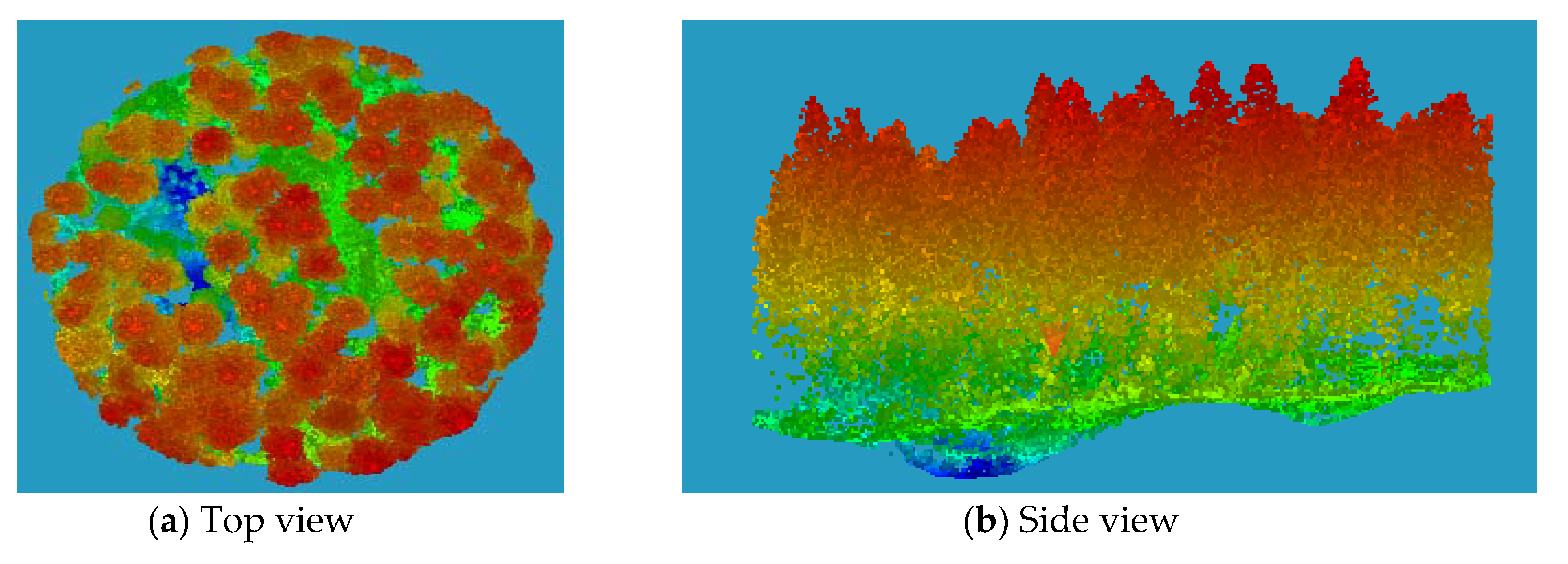
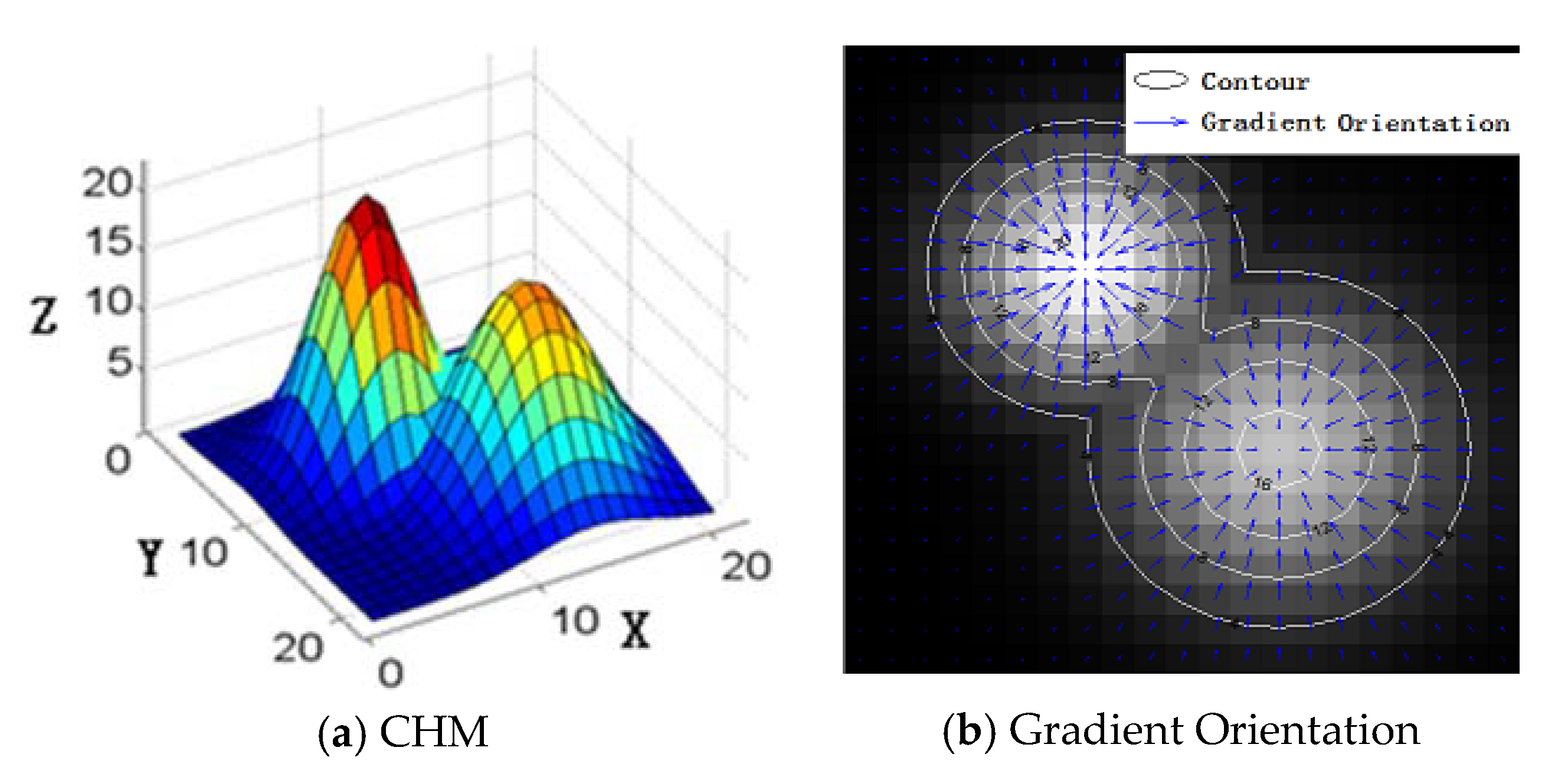
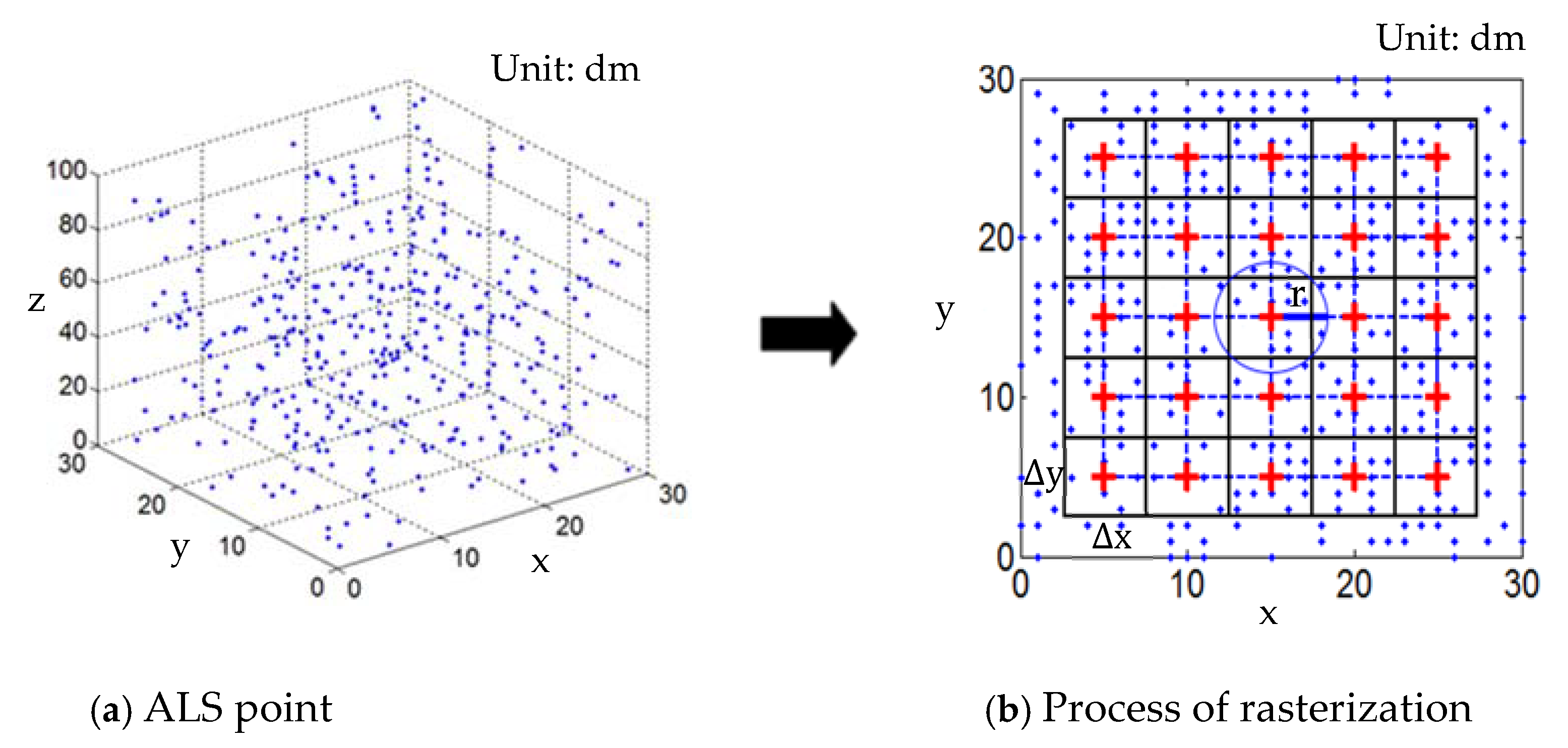

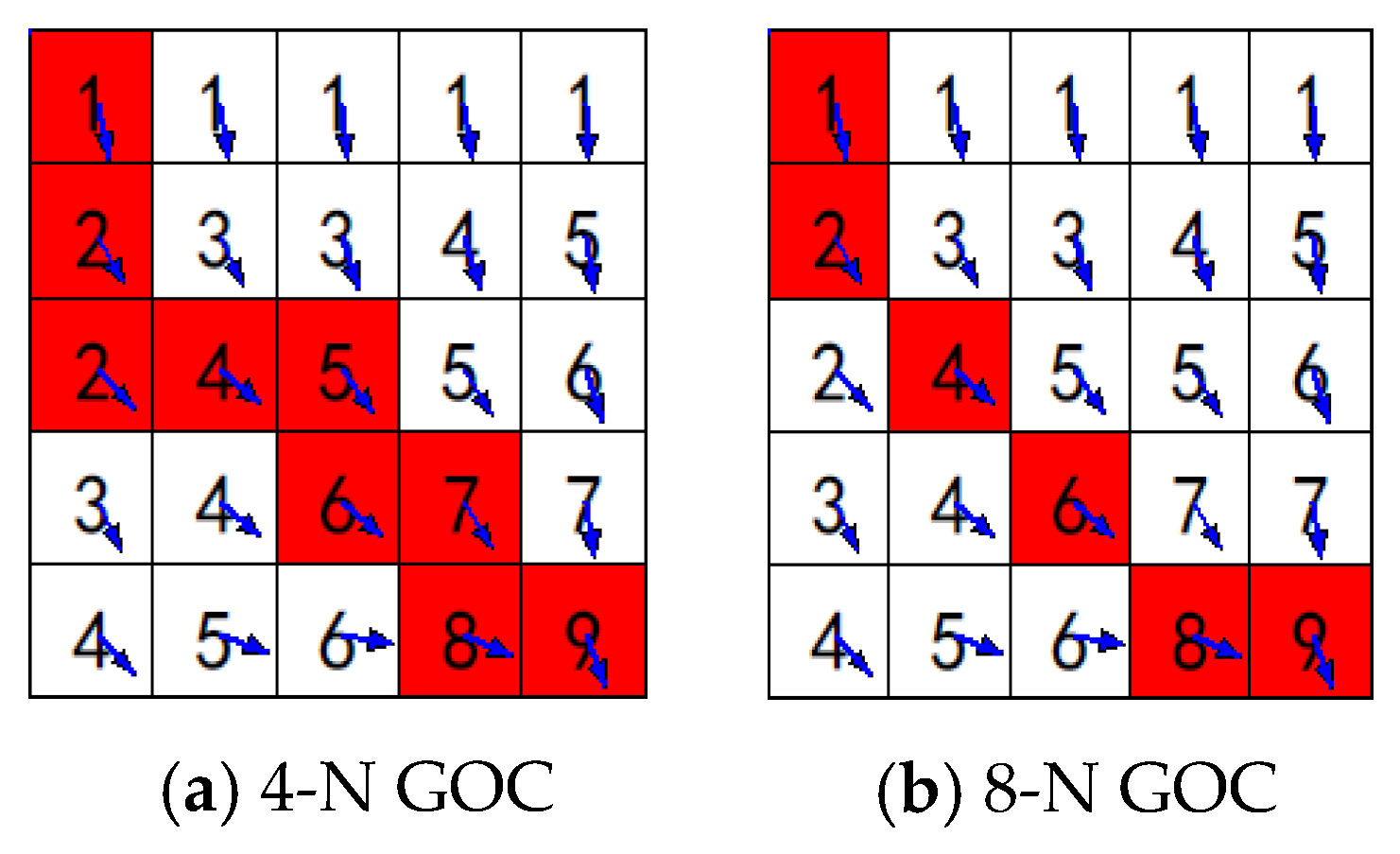
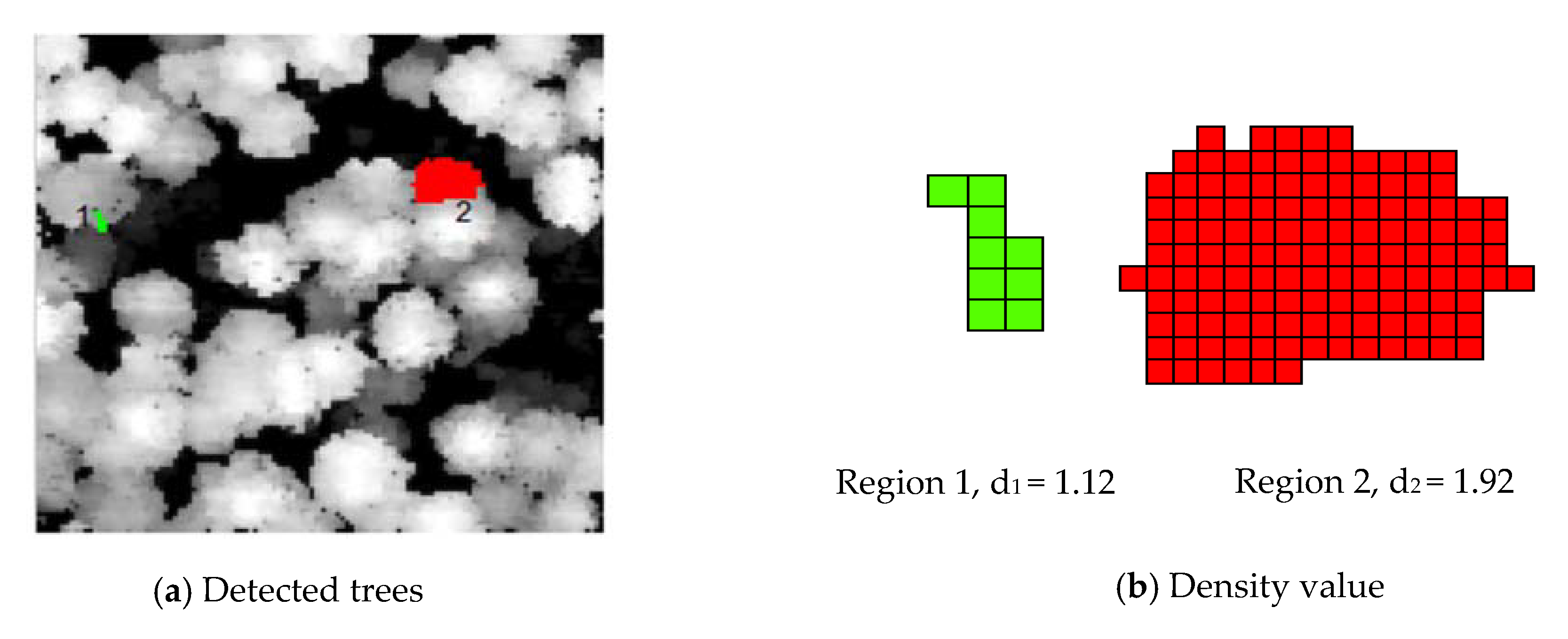
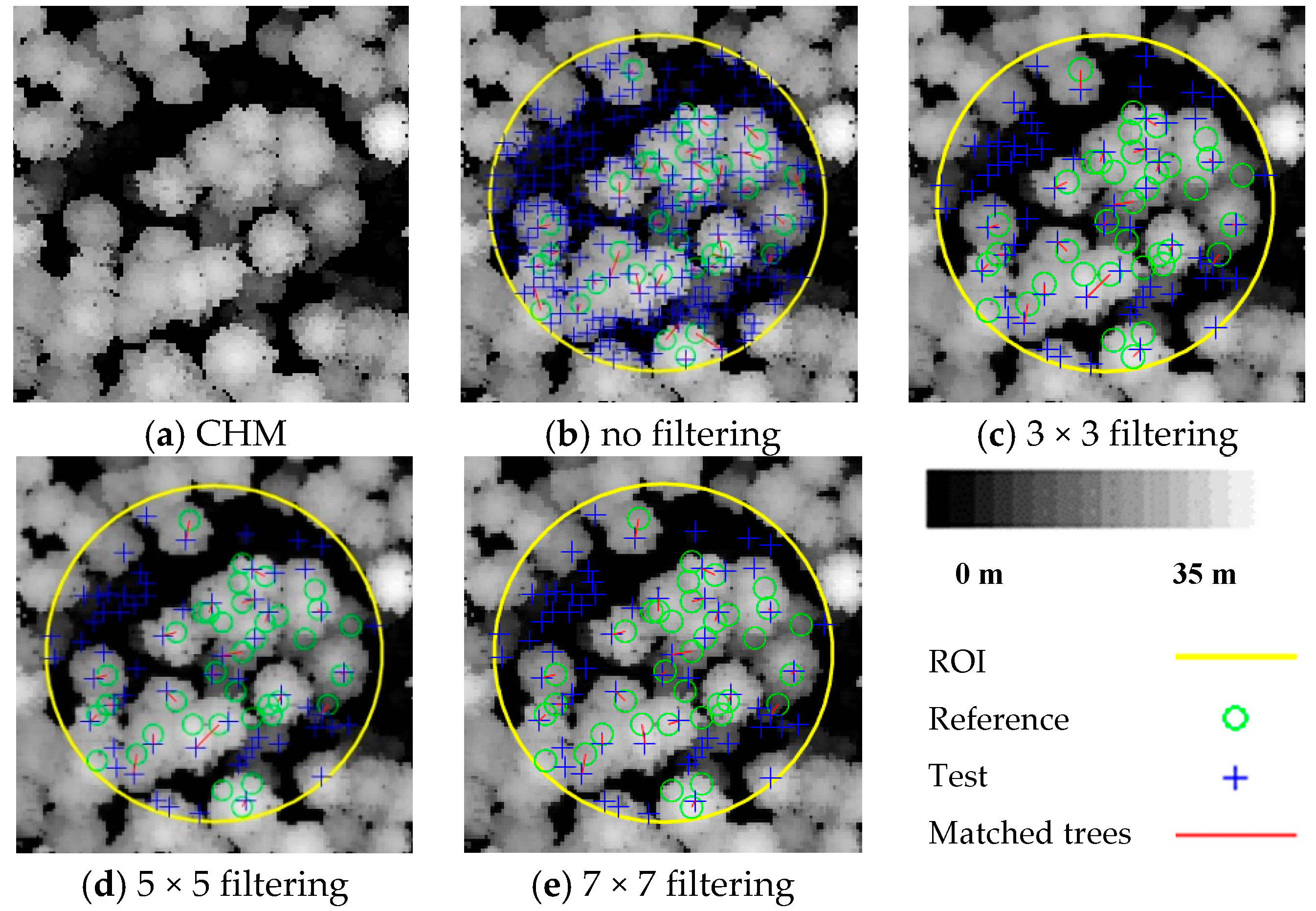
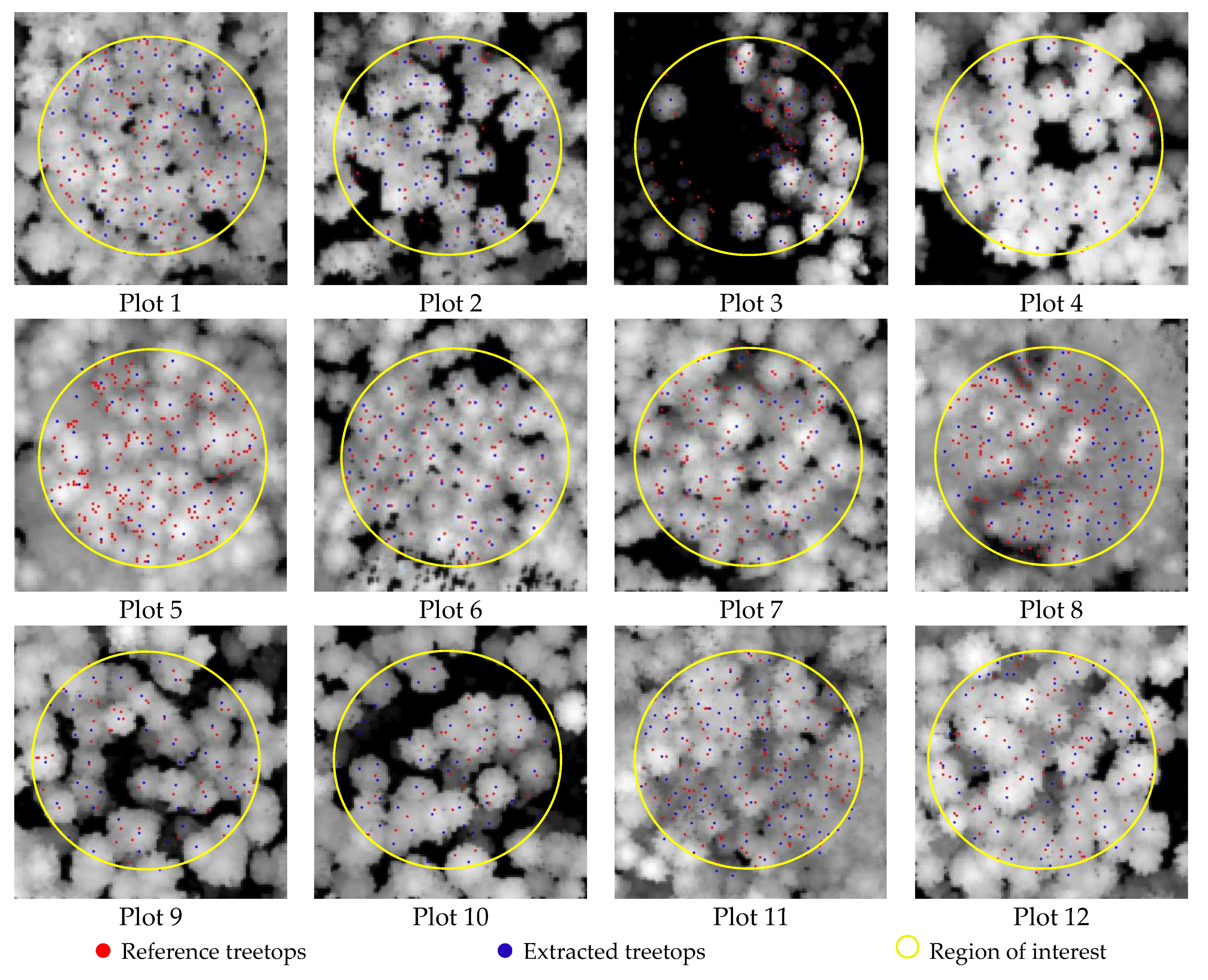



| Plot_ID | Region | Country | Main Species | Forest Type | Number of Reference Tree | Field Inventory Date (year/month) | ALS Date (year/month) |
|---|---|---|---|---|---|---|---|
| 1 | Cotolivier | Italy | Scots pine, larch, and spruce | ML/C | 106 | 2012/9 | 2012/7 |
| 2 | Scots pine and larch | SL/C | 49 | ||||
| 3 | Montafon | Austria | Spruce | ML/C | 101 | 2009/6 | 2011/9 |
| 4 | Pellizzano | Italy | Spruce, larch, and fir | SL/C | 46 | 2013/8 | 2012/9 |
| 5 | Larch, spruce, fir, sycamore, and poplar | ML/M | 235 | ||||
| 6 | Asiago | Italy | Spruce and fir | SL/C | 79 | 2012/10 | 2012/7 |
| 7 | Spruce, fir, and beech | ML/M | 106 | ||||
| 8 | Spruce, fir, and beech | ML/M | 168 | ||||
| 9 | Leskova | Slovenia | Fir, spruce, and beech | SL/M | 53 | 2008/11 | 2009/10 |
| 10 | Fir, spruce, and beech | SL/M | 37 | ||||
| 11 | Fir, spruce, beech, sycamore, and elm | ML/M | 117 | ||||
| 12 | Fir, beech and sycamore | ML/M | 92 |
| Plot_ID | 1 | 2 | 3 | 4 | 5 | 6 | 7 | 8 | 9 | 10 | 11 | 12 | RMS_M | |
|---|---|---|---|---|---|---|---|---|---|---|---|---|---|---|
| Size | ||||||||||||||
| no filtering | 42 | 44 | 43 | 37 | 25 | 56 | 49 | 36 | 31 | 39 | 54 | 34 | 41 | |
| 3 × 3 | 43 | 46 | 44 | 34 | 29 | 56 | 52 | 31 | 36 | 45 | 48 | 49 | 43 | |
| 5 × 5 | 43 | 46 | 43 | 34 | 29 | 56 | 51 | 31 | 37 | 45 | 48 | 50 | 43 | |
| 7 × 7 | 44 | 46 | 42 | 48 | 35 | 53 | 45 | 31 | 38 | 45 | 41 | 45 | 42 | |
| Plot_ID | Ntest | Nref | Nmatch | Rextr | Rmat | Rcom | Rom | Hmean | Vmean | M | |
|---|---|---|---|---|---|---|---|---|---|---|---|
| Td | |||||||||||
| 0 | 91 | 37 | 29 | 246% | 78% | 68% | 22% | 1.7 m | 1.2 m | 46 | |
| 1.2 | 64 | 37 | 28 | 173% | 76% | 76% | 24% | 1.8 m | 1.2 m | 49 | |
| 55 | 37 | 27 | 149% | 73% | 51% | 27% | 1.9 m | 1.3 m | 48 | ||
| 1.4 | 35 | 37 | 24 | 95% | 65% | 31% | 35% | 1.8 m | 1.2 m | 49 | |
| Method | Resolution | k1, k2 | Td | RMS_M |
|---|---|---|---|---|
| 4-N | 0.3 m | 1.7, 0.65 | 1.505 | 36 |
| 1.55, 0.5 | 1.4 | 37 | ||
| 1.4, 0.35 | 1.295 | 37 | ||
| 0.5 m | 1.7, 0.65 | 1.375 | 41 | |
| 1.55, 0.5 | 1.3 | 43 | ||
| 1.4, 0.35 | 1.225 | 43 | ||
| 0.7 m | 1.7, 0.65 | 1.245 | 38 | |
| 1.55, 0.5 | 1.2 | 37 | ||
| 1.4, 0.35 | 1.155 | 37 | ||
| 8-N | 0.3 m | 1.7, 0.65 | 1.505 | 40 |
| 1.55, 0.5 | 1.4 | 40 | ||
| 1.4, 0.35 | 1.295 | 40 | ||
| 0.5 m | 1.7, 0.65 | 1.375 | 36 | |
| 1.55, 0.5 | 1.3 | 36 | ||
| 1.4, 0.35 | 1.225 | 36 | ||
| 0.7 m | 1.7, 0.65 | 1.245 | 33 | |
| 1.55, 0.5 | 1.2 | 33 | ||
| 1.4, 0.35 | 1.155 | 32 |
| Resolution | Method | RMS_Rextr (%) | RMS_Rmat (%) | RMS_Rcom (%) | RMS_Rom (%) | RMS_H (m) | RMS_V (m) | RMS_M |
|---|---|---|---|---|---|---|---|---|
| 0.3 m | 4-N | 149 | 57 | 49 | 49 | 2.0 | 1.1 | 37 |
| 8-N | 249 | 68 | 62 | 36 | 2.0 | 1.0 | 41 | |
| 0.5 m | 4-N | 124 | 63 | 42 | 42 | 1.9 | 1.0 | 43 |
| 8-N | 108 | 53 | 43 | 50 | 1.9 | 1.0 | 36 | |
| 0.7 m | 4-N | 65 | 48 | 23 | 54 | 1.9 | 0.8 | 38 |
| 8-N | 59 | 42 | 28 | 60 | 1.8 | 0.9 | 32 |
| ID | Method | RMS_Rextr | RMS_Rmat | RMS_Rcom | RMS_Rom | RMS_H | RMS_V | RMS_M |
|---|---|---|---|---|---|---|---|---|
| 1 | LM + filtering | 51% | 45% | 9% | 59% | 1.6 m | 0.9 m | 40 |
| 2 | LM + region growing | 57% | 43% | 20% | 61% | 1.8 m | 1.2 m | 35 |
| 3 | LM + multi CHM | 101% | 46% | 61% | 57% | 1.7 m | 0.7 m | 28 |
| 4 | LM + Watershed | 86% | 49% | 49% | 55% | 1.6 m | 1.1 m | 32 |
| 5 | Segment + Clustering | 139% | 53% | 95% | 51% | 1.7 m | 1.0 m | 27 |
| 6 | LM 3 × 3 | 154% | 54% | 113% | 51% | 1.6 m | 0.9 m | 25 |
| 7 | LM 5 × 5 | 52% | 41% | 16% | 63% | 1.8 m | 1.1 m | 34 |
| 8 | Polyn. Fitting + Watershed | 54% | 44% | 13% | 59% | 1.8 m | 1.1 m | 38 |
| 9 | GOC | 124% | 63% | 42% | 42% | 1.9 m | 1.0 m | 43 |
| Forest Type | SL/M | SL/C | ML/M | ML/C |
|---|---|---|---|---|
| RMS_Rext | 163% | 139% | 116% | 74% |
| RMS_Rmat | 73% | 73% | 57% | 52% |
| RMS_Rcom | 54% | 44% | 41% | 30% |
| RMS_Rom | 27% | 27% | 48% | 50% |
| RMS_H | 1.8 m | 1.7 m | 2.0 m | 1.7 m |
| RMS_V | 1.1 m | 1.0 m | 0.9 m | 1.1 m |
| RMS_M | 47 | 51 | 39 | 39 |
© 2018 by the authors. Licensee MDPI, Basel, Switzerland. This article is an open access article distributed under the terms and conditions of the Creative Commons Attribution (CC BY) license (http://creativecommons.org/licenses/by/4.0/).
Share and Cite
Dong, T.; Zhou, Q.; Gao, S.; Shen, Y. Automatic Detection of Single Trees in Airborne Laser Scanning Data through Gradient Orientation Clustering. Forests 2018, 9, 291. https://doi.org/10.3390/f9060291
Dong T, Zhou Q, Gao S, Shen Y. Automatic Detection of Single Trees in Airborne Laser Scanning Data through Gradient Orientation Clustering. Forests. 2018; 9(6):291. https://doi.org/10.3390/f9060291
Chicago/Turabian StyleDong, Tianyang, Qizheng Zhou, Sibin Gao, and Ying Shen. 2018. "Automatic Detection of Single Trees in Airborne Laser Scanning Data through Gradient Orientation Clustering" Forests 9, no. 6: 291. https://doi.org/10.3390/f9060291
APA StyleDong, T., Zhou, Q., Gao, S., & Shen, Y. (2018). Automatic Detection of Single Trees in Airborne Laser Scanning Data through Gradient Orientation Clustering. Forests, 9(6), 291. https://doi.org/10.3390/f9060291




